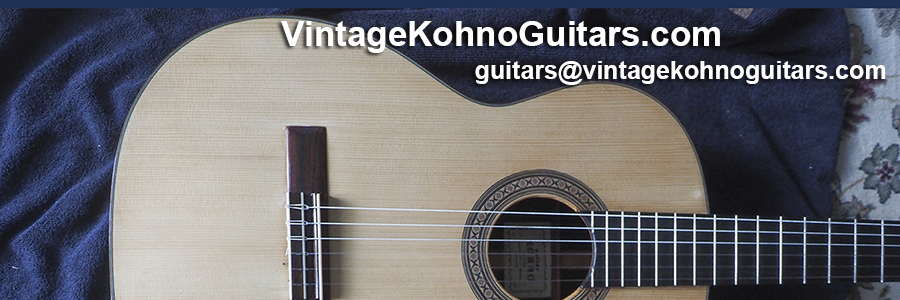`Masaru Kohno 1926-1998
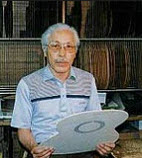
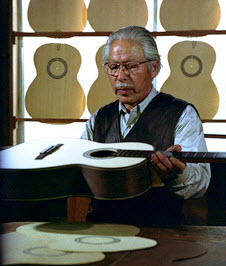
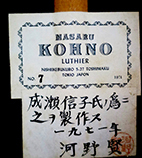
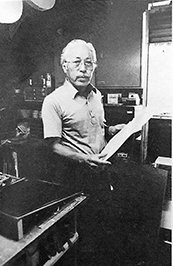
Ivor Mairants writes about Masaru Kohno in his book "My Fifty Fretting Years" published in 1980.
"In 1963 I first met Masaru Kono who has since changed the spelling of his last name to Kohno. He then produced a whole range of excellent classical guitars from No 2 to No 10, and when my order was delivered in London in the autumn, Julian Bream happened to come into the shop and asked if I had any "new machines" I showed him the Kohnos and it did not take long for him to select one of the lower priced models (about 80 pounds), take it away, and use it in concerts. He tells me he still has it and uses it.
The people who still may be wondering what caused the Japanese to become guitar makers may well wonder how Masaru Kohno learnt his craft. Well, during 1959 he went to Madrid and presented himself at No 12 Jesus y Maria, the workshop of Arcangel Fernandez, and, through a friend who spoke Spanish, asked if he could watch Arcangel at work, Arcangel, being a most friendly and straightforward person, did not object, and so the visits began. Masaru Kohno would often take Arcangel out to lunch or dinner, and generally treated him with great friendship which Arcangel reciprocated. Between interpreters and drawings, Arcangel's work was carefully noted by Kohno, and after visits almost every day for about six months, Masaru had seen enough for his purpose, and left Madrid to establish his own workshop in Tokyo. Ivor Mairants relates the story below without comment as it was told to him by Arcangel.
Masaru Kohno entered one of his guitars at the Liege Concours
National de Guitares which was held September 10-19 in 1967, and won the first prize for guitar
making out of 31 entrants. The chairman of the adjudicators
was my late lamented friend Ignacio Fleta (who died in 1977) and he
told me that when he examined Kohno's guitar (which of course was
unlabeled at the time) he thought it was very much like his own."
(On the judge's panel were, among others,
Ignacio Fleta, Robert Bouchet, Joaquin Rodrigo, and Alirio Diaz, Noted French Luthier Daniel Frederich won the Silver medal
in the competition, a sale
of a Frederich in 2015 brought $60,000 US dollars).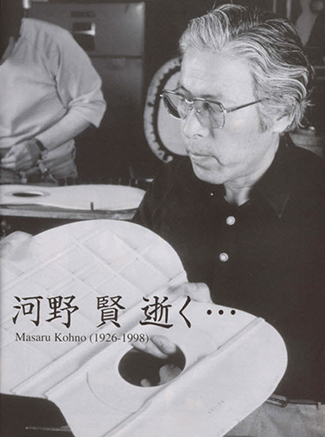
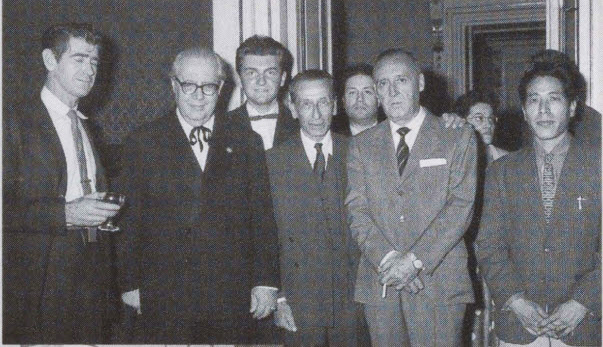
Kohno (far right) in Spain with Segovia, Tansuman, and Jose Tomas in
1960. At the seminar
of Santiago de Compostela (the capital of
northwest Spain's Galicia region) Courtesy of Gendai Magazine
In the Development of Modern Guitar John Huber writes,
"Kohno, already considered Japan's best maker, studied in Barcelona with Fleta. Upon his return to Tokyo (1960), he buried the western stereotype of Japanese production by not showing the slightest inclination to merely make polite imitations of Spanish guitars. Indeed, he proceeded to challenge them for market supremacy. He developed his own "Torres" model, with a comfortable neck for hands smaller and less powerful than Segovia's and a strong voice with brilliant trebles and clear bases. It soon won the prestigious Queen Elizabeth prize for its tone. By the late 60's Kohono's guitars had won not only a worldwide reputation for consistent excellence at low price, but also a worldwide market for far more than he ever could produce himself. With the assistance of his nephew (Sakurai), he responded with a modern factory, which for the next two decades provided the world with a Ramirez alternative in quality. Kohno's segment of the market continued to increase until the mid-80's when a general decline in guitar sales, after an uninterrupted 30 year market expansion, restricted growth of both Kohno's and most other competing guitar makers. Similar to the situation in Madrid, where many craftsman can trace their origins to the Ramirez workshops, in Tokyo, many of the best independent guitar makers to emerge in the 70' were former Kohno employees."
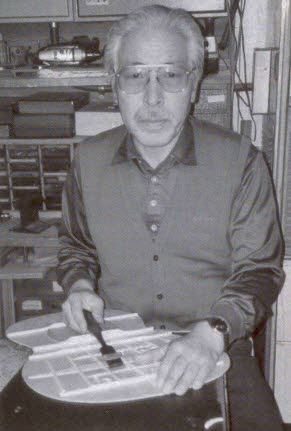 Courtesy
of Gendai magazine
Courtesy
of Gendai magazine
Bill Baker on Masaru Kohno
Over the years I have played several Fletas
and remember a most distinctive aromatic smell inside the guitar. Not
having known the above, when I purchased my first Kohno (a 1971 No
7) I held up the guitar and the scent transported me back
thirty years to that same distinct smell the Fleta I played possessed. Its sound reminded me so much of
the Fletas, that I wrote Masaki Sakurai
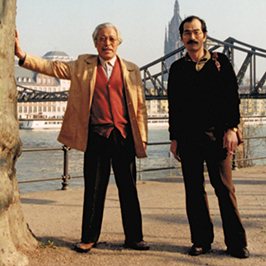 (Kohno's nephew and
protégé)
asking if Kohno had studied with Fleta. He wrote back confirming
that Masaru Kohno indeed did study with Fleta. While we have a
documented writing of the history of Kohno studying with Archangel
Fernandez, little is known of Kohno's association with Fleta other
than the fact that upon his return to Tokyo in 1960, not only did he
bring back a Fleta to study, but the head design
of his guitars changed to a style closely resembling the Fleta head, Photo courtesy of Masaki Sakurai
(Kohno's nephew and
protégé)
asking if Kohno had studied with Fleta. He wrote back confirming
that Masaru Kohno indeed did study with Fleta. While we have a
documented writing of the history of Kohno studying with Archangel
Fernandez, little is known of Kohno's association with Fleta other
than the fact that upon his return to Tokyo in 1960, not only did he
bring back a Fleta to study, but the head design
of his guitars changed to a style closely resembling the Fleta head, Photo courtesy of Masaki Sakurai
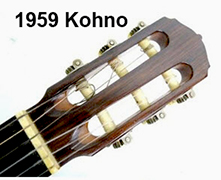

 a drastic change from his 1959 head style, and nothing even remotely
resembling Archangel Fernandez's head design. Fleta's comment at the
Leige (Belgium) concours 1967 was he thought the unlabeled Kohno
closely resembled his own guitars. It was apparent then that
Kohno was an international master builder.
Ignacio Fleta, Robert Bouchet, Joaquin Rodrigo, and Alirio Diaz
agreed giving Kohno's guitar first prize in a field of 31
competitors that included Danial Frederich.
a drastic change from his 1959 head style, and nothing even remotely
resembling Archangel Fernandez's head design. Fleta's comment at the
Leige (Belgium) concours 1967 was he thought the unlabeled Kohno
closely resembled his own guitars. It was apparent then that
Kohno was an international master builder.
Ignacio Fleta, Robert Bouchet, Joaquin Rodrigo, and Alirio Diaz
agreed giving Kohno's guitar first prize in a field of 31
competitors that included Danial Frederich.
I have owned
many Kohnos and they have all been concert quality guitars.
The guitars offered on this site are top-level concert guitars at an
affordable price for the player that appreciates a vintage
instrument with minor cosmetic flaws. My background includes 40
years of guitar playing, a BFA in classical guitar performance from
the University of New Mexico, four summers of playing and studying
under Emilio Pujol at his International Course of Guitar Lute and
Vihuela in Cervera Spain. Associate professor under Hector Garcia at
UNM, numerous recordings, and concerts. I play with fingertips
so the sound will be somewhat different than those who play with
fingernails. The sound recordings of the guitars are my own.
As Kohno grew his business over the years his numbering system
changed. First he started with simple numbers like 421 and
821. I suspect those numbers stood for finish dates 421 being
April 21. Then he started model numbers like no 4, no 5 no 10 etc.
Where the number reflected the price in Japanese yen. As time
passed the numbers grew in size to reflect new pricing. So a model
No 30 would have been 300,000 yen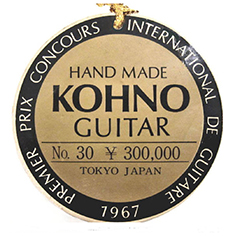 and a model No15 would have been
150,000 yen. I suspect he did this because of the high level of
inflation in Japan in the early '70s and the increase in demand for
his guitars. He needed to raise his model
numbers to keep up with the changing Yen value. The numbers grew to
a No 50 model and finally a number 80 model. Around 1982 he began calling his models, Maestro,
Special, Professional, and Concert. While the numbers reflected the
fanciness of the guitar, the sound quality of the instruments wasn't
necessarily better as Julian Bream proved when he chose a lower
priced model number out of a batch of Kohnos in Ivor Mairants's
shop. My good friend and renown painter Manuel Lopez Cia would
comment at shows when people would stick thier noses up to one of
his works. "Paintings are meant to be seen, not smelled." The
same can be said of vintage guitars. They are meant to be
heard and not nitpicked for cosmetic flaws. You want structural
integrity, playability and sound to be the driving factors in your
decision to purchase any vintage guitar.
and a model No15 would have been
150,000 yen. I suspect he did this because of the high level of
inflation in Japan in the early '70s and the increase in demand for
his guitars. He needed to raise his model
numbers to keep up with the changing Yen value. The numbers grew to
a No 50 model and finally a number 80 model. Around 1982 he began calling his models, Maestro,
Special, Professional, and Concert. While the numbers reflected the
fanciness of the guitar, the sound quality of the instruments wasn't
necessarily better as Julian Bream proved when he chose a lower
priced model number out of a batch of Kohnos in Ivor Mairants's
shop. My good friend and renown painter Manuel Lopez Cia would
comment at shows when people would stick thier noses up to one of
his works. "Paintings are meant to be seen, not smelled." The
same can be said of vintage guitars. They are meant to be
heard and not nitpicked for cosmetic flaws. You want structural
integrity, playability and sound to be the driving factors in your
decision to purchase any vintage guitar.
Guitars improve with age, but more than anything else they improve by being constanty played.
.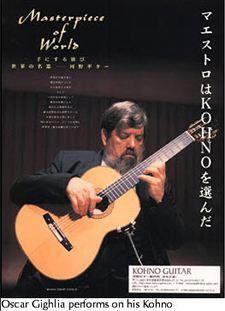
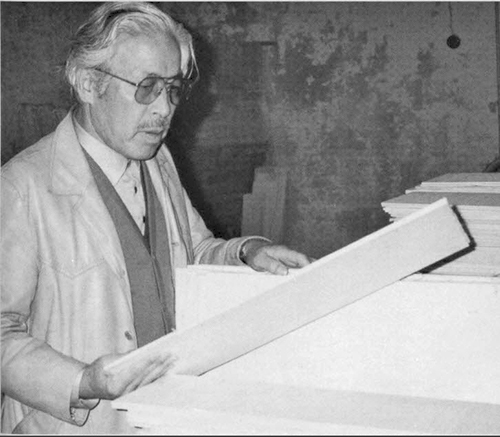
Below is courtesy of Dave Tate
"Masaru Kohno (1926-1998) is not only
the most important luthier to emerge from Japan, but also one of the
best worldwide. He was born in Mito City, Japan, and in 1948 he
graduated from the Tokyo College of Arts and Crafts with a degree in
woodcraft. It was during this time that he became interested in
guitar construction, and in 1959 he traveled to Spain to learn the
craft.
Kohno apprenticed for six months at the workshop of
Arcangel Fernandez, and although neither could speak a word of the
other's language, they managed to communicate. Kohno's
apprenticeship consisted mostly of sitting in the back of the shop
and quietly–-but attentively--observing the master Fernandez at
work.
Kohno's quiet learning paid off. Upon his return to
Tokyo he established his own workshop and quickly gained recognition
among Japanese guitarists. His international debut came in 1967,
when he was awarded the Gold Medal at the Elizabeth's Concourse
International Guitar Building Competition in Belgium. On the judge's
panel were, among others, Ignacio Fleta, Robert Bouchet, Joaquin
Rodrigo, and Alirio Diaz.
Since then, many players of world
renown have used Kohno guitars; among them are Julian Bream, Oscar
Gighlia, and Sharon Isbin, to name a few."
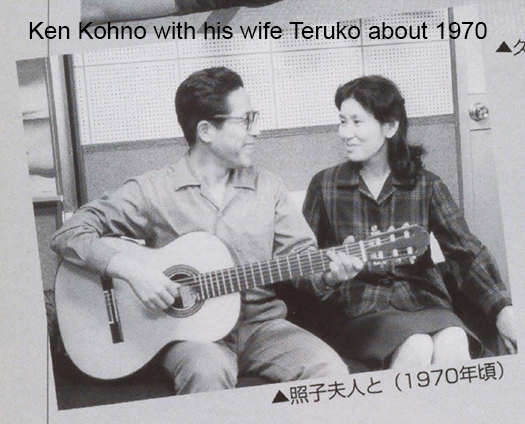
Photo courtesy of Gendai magazine.
Graham Wade writes in The Classical Guitar Complete History
"A wide variety of recitalists have
played his guitars, including Julian Bream, Vladimir Mikulka and
John Mills. Both Sharon Isbin's Classical Guitar Vol II: Bach,
Britten, Brower and Martin Mysilveck's Umlecky Portret Martina
Msylivecka, (Panton, 1981) were recorded on Kohno guitars.
Frederic Zigante is currently using a Kohno guitar in concert and on
his recordings which include the complete guitar works of
Villa-Lobos and Paganini. He is currently professor of guitar at the
Conservatory of Trieste, Italy, and has concertizes over
Europe, Japan and China.
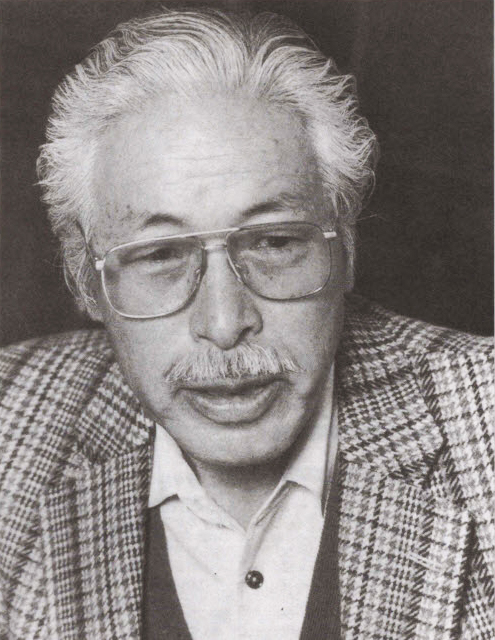
Photo courtesy of Gendai magazine
James Bishops-Edwards writes this on Kohno
I think Kohno was making a
more playable and musical guitar than the 70's and 80's Ramirez, but
you can see the influence in the string length, ebony neck
reinforcement strips, and other nuances. I had a 1982 664mm
string length Ramirez that gave me tendinitis which was seriously
debilitating, and my hands are good sized and fingers are sturdy.
I like a good Ramirez but the influence of Segovia's big
hands on the
neck width and string length was a bad turn in the history of guitar
making. Many people struggled, and still do, to play the
Spanish 2x4 neck of that period. Kohno must have been
influenced by the marketplace, but he made a more interesting and
playable guitar than the Spaniards within that paradigm, in my
(newly formed) opinion. I studied for awhile with Ray
Reussner, who studied with Segovia in the 60's and beyond. He
said he asked Segovia once why he switched from the Hauser to
Ramirez, and although I'm sure Spanish pride had something to do
with it, Segovia's answer was the Hauser neck was too small now.
So one man's large hands influenced a generation of Spanish makers;
wild. I remember a Japanese student of Parkening's in the 70's
struggling mightily with his big Ramirez. On the other hand
we're lucky; if Segovia had started touring the world with a new
Kohno in 1963, the 60's Kohno's would be (if you could get one) in
the $40,000 and up price range. So we can thank the Spanish
tradition for the part it played in Kohno's work, and Segovia for
distracting the world in the direction of Ramirez. :) Thanks again
for your website and knowledge; I was fortunate to discover it.
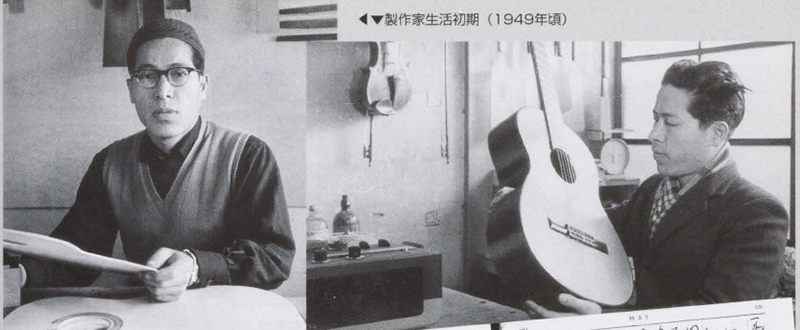
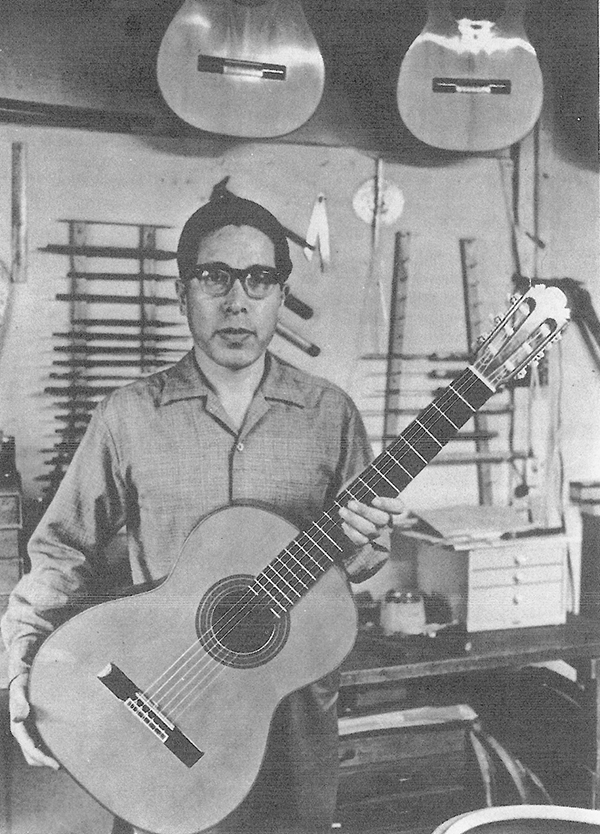
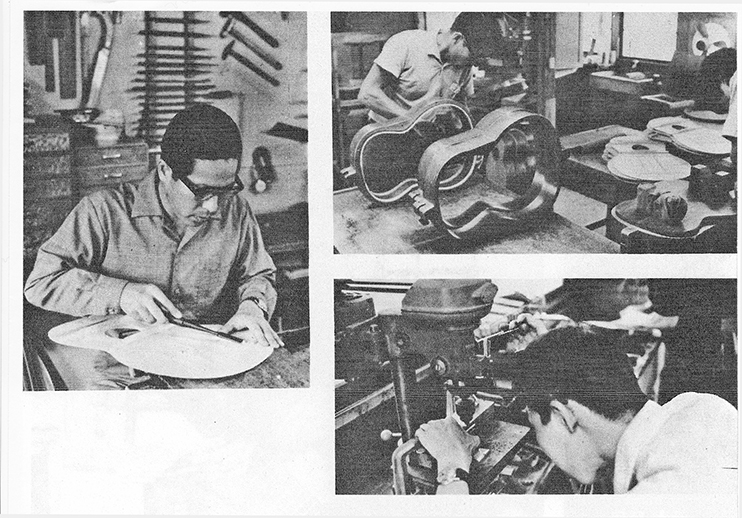
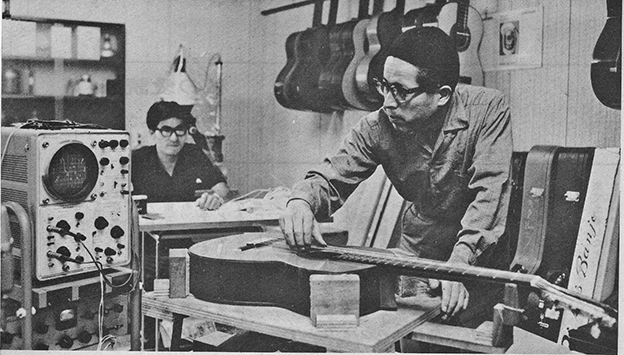
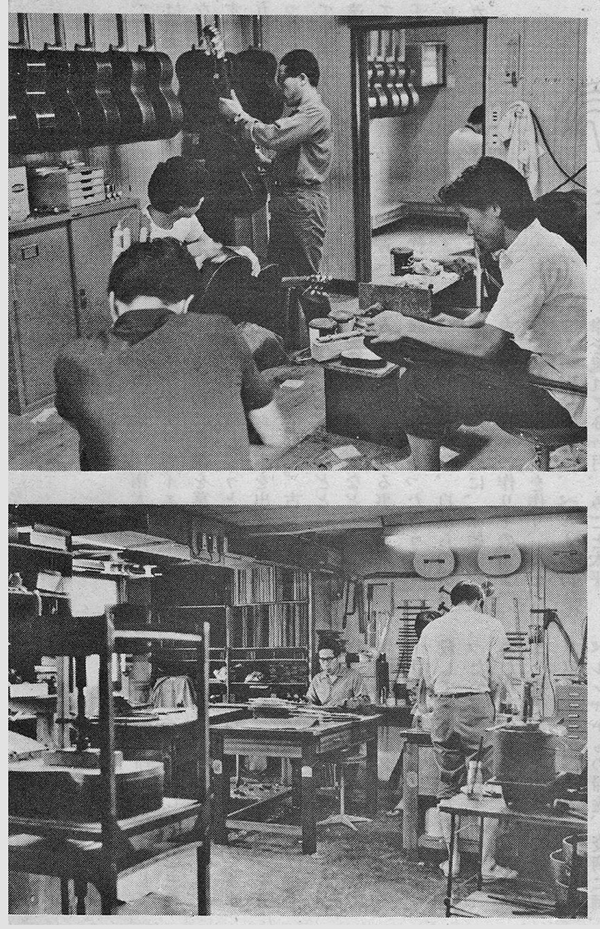
Photos courtesy of Gendai magazine
Summerfield further
writes "Masaru Kohno who died 13 December 1998 is regarded as one of
the most important of the 20th century classical guitar makers.."
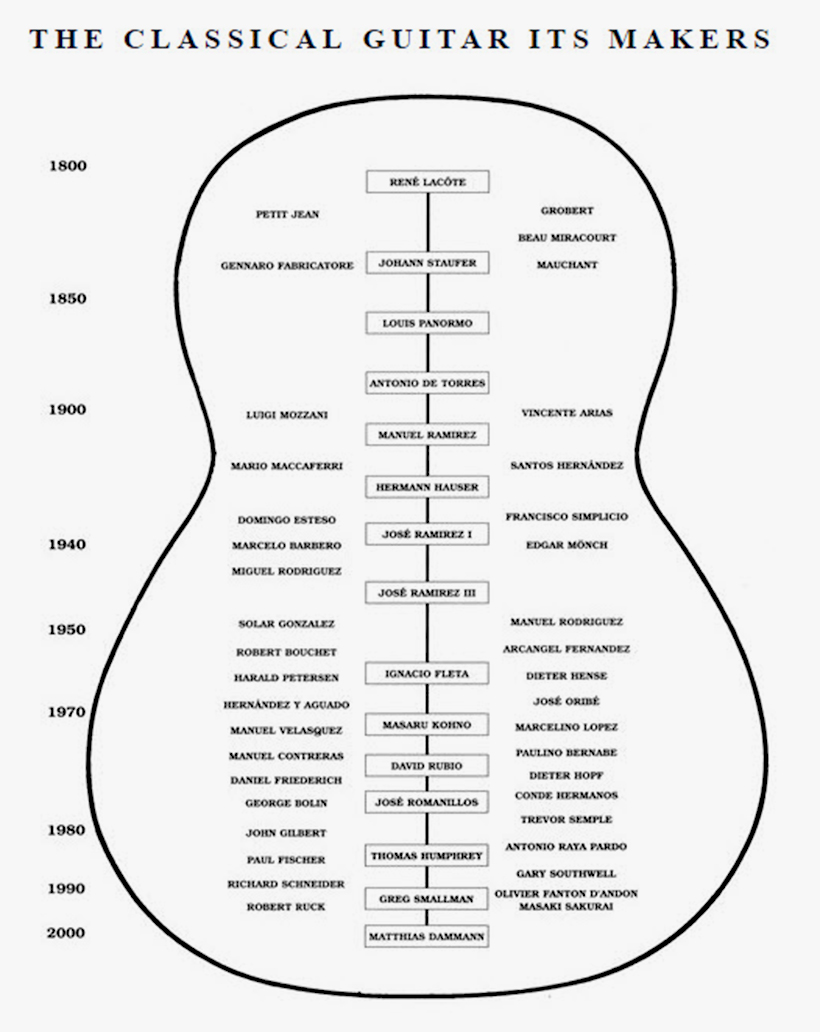
Photo courtesy of Maurice Summerfield
.
Purchase a guitar with confidence.
We accurately rate our guitars on quality of sound and appearance. Our guitars are carefully examined and assessed. Any repair work if needed is completed by a master luthier. Recordings of each instrument enable you to choose the best guitar for your collection.
